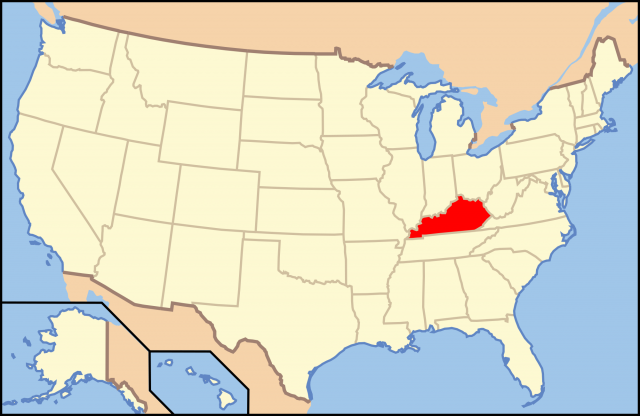The State of Kentucky
AT A GLANCE
Name: Kentucky is from the Iroquois word Ken-tah-ten, which means “land of tomorrow.”
Nickname: Bluegrass State
Capital: Frankfort
Size: 40,411 sq. mi. (104,665 sq km)
Population: 4,425,092 (2015 est)
Statehood: Kentucky became the 15th state on June 1, 1792.
Electoral votes: 8 (2016)
U.S. Representatives: 6 (until 2016)
State tree: tulip poplar
State flower: goldenrod
State animal: gray squirrel
Highest point: Black Mountain, 4,145 ft. (1,263 m)

THE PLACE
Kentucky is located in the south central United States and is bordered by seven states: Indiana, Ohio, West Virginia, Virginia, Tennessee, Missouri, and Illinois. The Mississippi River forms Kentucky's western border, and the state's eastern border lies in the Appalachian Mountains. The eastern part of the state is mountainous and forested and has several large coal deposits. The Bluegrass Region, in the north central part of the state, is an area of gently rolling hills covered by the grass that gives the region its name. Some tobacco and corn is grown there. Most of Kentucky's famous thoroughbred horse farms are located in this region.
About two-thirds of the state's coal reserves are located in the northwestern region. To the south are the Mississippi floodplain and more gently rolling farmlands, as well as some of the longest cave systems in the world.
Forests cover about half of Kentucky. The state's climate is warm and rainy, with humid summers and cool winters. Most snow falls in the southern half of the state.
Facts and Firsts
- Bluegrass is not really blue—it is green. In the spring, bluegrass produces bluish-purple buds. When a large number of these buds grow close together in a field, they give a blue cast to the grass.
- Middlesboro is the only city in the United States built inside a meteor crater.
- The Kentucky Derby, first run in 1875, is the oldest continuously held horse race in the United States. Each May, thousands of spectators come to the Churchill Downs racetrack in Louisville for the “run for the roses”—the blanket of roses presented to the winning horse and jockey.
- In 1887, Kentucky schoolteacher Mary Towles Sasseen Wilson held the first observance of Mother's Day. Mother's Day received national recognition in 1914. On May 9 of that year, President Woodrow Wilson signed a resolution that recommended Congress and the executive branch of the federal government observe Mother's Day. The next year, Wilson proclaimed Mother's Day an annual national observance.
- In 1893, two Louisville sisters, Mildred Hill and Patty Hill, created the song that became “Happy Birthday to You.”
- The largest amount of gold in the world, more than $6 billion in the form of gold bullion, is stored underground at Fort Knox.
THE PAST
When British, French, and American explorers arrived in the Kentucky area in the 1600s and 1700s, they found many different Native American tribes living there. In 1774, James Harrod led a group of settlers from Pennsylvania into Kentucky and established the first permanent white settlement, Harrodsburg. The Native Americans, including Cherokee, Delaware, Iroquois, and Shawnee, were not willing to give up their land to the settlers without a fight. They waged war against the newcomers. Pioneers, including the legendary Daniel Boone, defended the settlers from the Native Americans.
Kentucky became a U.S. territory and later, in 1792, a state. After Kentucky became a state, its population increased and more areas of farmland were opened to settlement. Farmers grew hemp and tobacco, as well as corn, rye, and other grains used to manufacture alcoholic beverages. Horse breeders began to move into the Bluegrass Region for its rich soil and grass.
Slavery was central to the state's agricultural economy. The abolition of slavery after the Civil War hurt Kentucky's horse breeding and tobacco industries; the state's growth and economic progress slowed. Agriculture in Kentucky suffered again during the Great Depression of the 1930s, when residents began to move from farms to the cities in search of work.
The demand for food and war materials during World War II helped Kentucky restore its economy. After the war, manufacturing grew, and Kentucky began to shift from an agricultural to an industrial economy. During the 1960s, coal mining expanded greatly, and the construction of new highways increased tourism throughout the state.
THE PRESENT
Kentucky has long been known for its tobacco, racehorses, and whiskey. Today, Kentucky produces more burley tobacco and bourbon whiskey than any other state.
Huge deposits of coal and other mineral resources have made the state an important mining center. Manufacturing, too, has made Kentucky into an urban, industrial state. Automobiles and automobile parts are now the most valuable of Kentucky's manufactured goods. Other goods manufactured there include aircraft parts, pharmaceutical products, paints, industrial cleaners, elevators, typewriters, and printers.
Tourist attractions such as Cumberland Falls, Mammoth Cave, and Land Between the Lakes make Kentucky a popular vacation spot. The Kentucky Derby also attracts tourists from all over the world.
Born in Kentucky
- Muhammad Ali, boxer
- Louis D. Brandeis, jurist
- Christopher “Kit” Carson, scout
- George Clooney, actor
- Rosemary Clooney, singer
- Jefferson Davis, president of the Confederacy
- Johnny Depp, actor
- Naomi Judd and Wynonna Judd, singers
- Abraham Lincoln, U.S. president
- Diane Sawyer, broadcast journalist
- Robert Penn Warren, novelist